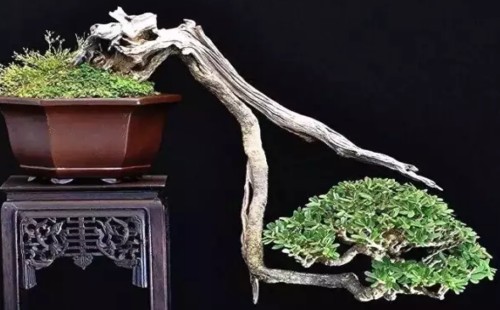How to bend the cliff bonsai
Cliff-style bonsai generally refers to the cliff-like tree stump bonsai, because the pile modeling is strange and precipitous, and the creative techniques are flexible and changeable, so as a bonsai masterpiece, it can often resonate with the appreciator. and cliff bonsai can also bring people a kind of artistic conception of active efforts and brave struggle. However, most of the backbone of cliff-style bonsai is not naturally curved, but mostly deliberately created by manual work in the later stage. So, how do cliff bonsai bend tree trunks?

Bending is the most important link in the process of making cliff bonsai, how to bend well, first of all, we should understand the modeling characteristics of cliff bonsai, and then use scientific methods to create. The modeling techniques of cliff-style bonsai are generally flexible and changeable, and they have to apply the law in accordance with their aptitude in the process of building. Generally, there is no unified and strict rules that can be applied, and there is no only standard, so they are relatively free in the modeling process and are not restricted by various so-called rules.
In general, the production of cliff-style bonsai can be created boldly according to the creator's modeling intention, and the original generally does not leave a support in the lower part of the pile scene. For ordinary pile scenes, all kinds of modeling effects should be satisfied that the trunk can keep branches all around, while for cliff modeling, it is generally required to keep branches in three directions. The branches at the lower end of the dry body are often obtained according to the outward growth of the front and back branches and the low curvature of the branches, which can effectively avoid the phenomenon of shade branches.
After understanding the modeling characteristics of cliff-style bonsai, we can bend the dry part according to these characteristics. However, if there is a pile scene with better natural conditions, it is often done with twice the result with half the effort. As some trees on the edge of the cliff are restricted by the environment, they tend to grow in the direction of the sun and wide space, and they will form a hanging root over a long time. The dry body will also reach out beyond the cliff, rely on the rhizome to grasp the ground, and the root system is in the opposite direction of extension. Therefore, such pile landscapes are often easier to build into cliff bonsai.
However, in addition to the natural cliff-shaped advantages of pile scenery, we also need to strengthen it with the help of certain techniques to make the bending more aesthetic. The simplest way to do this is to wind the trunk with wire, but if the trunk does not have the advantage of innate bending and requires a large bend, then you often need to bend the wire or plastic tape before winding the wire, and then use wire winding to strengthen the bend until it is fixed.
In the process of bending and bending, the stress points can be dispersed with twine or plastic tape, reducing the risk of cracking and breaking. And even if there are some cracks, hemp thread, especially plastic tape, can only be wound together to support it, which is more conducive to the wound healing of the cracked part, and finally makes the cracks disappear. There was no crack at all in the later stage. This is often an effect that cannot be achieved with wire.
Through the use of two different bending treatments before and after, it can be found that the use of hemp or plastic tape is mainly to do a large amount of bending, while the use of wire winding is mainly to strengthen the details of the bending range. But the ultimate goal of the two is the same, both are to bend the tree trunk, so that it can play a different role in the process of making cliff bonsai.
Time: 2019-06-06 Click:
- Prev

How to shape the banyan bonsai
Banyan bonsai not only has numerous leaves and green branches, but also has a charming shape; it can not only see the roots, but also considerable leaves and shapes, all of which have extraordinary ornamental value. However, for a banyan bonsai, the perfect shape is generally not formed naturally, but is realized by the creator for a long time.
- Next

Bonsai how to break the pole and get the bend-the technique of taking the bend with the big pole
For bonsai trees, the bending of branches has always been a difficult aspect in the process of modeling processing, especially the bending of large poles. Because whether this link is handled well or not, it will directly affect the ornamental value of bonsai, and even the growth status. After all, taking the bend is one of the main means to build the bonsai skeleton.
Related
- Fuxing push coffee new agricultural production and marketing class: lack of small-scale processing plants
- Jujube rice field leisure farm deep ploughing Yilan for five years to create a space for organic food and play
- Nongyu Farm-A trial of organic papaya for brave women with advanced technology
- Four points for attention in the prevention and control of diseases and insect pests of edible fungi
- How to add nutrient solution to Edible Fungi
- Is there any good way to control edible fungus mites?
- Open Inoculation Technology of Edible Fungi
- Is there any clever way to use fertilizer for edible fungus in winter?
- What agents are used to kill the pathogens of edible fungi in the mushroom shed?
- Rapid drying of Edible Fungi

